In Focus
Aug 31, 2023
A “floating world” of resilience, positivity, and laughter
Though first launched in 2016, TikTok only started gaining its now-immense popularity during the COVID-19 pandemic, with users embracing the platform’s opportunities to showcase artistic expression and creativity and thereby acquiring a sense of solace during their lonesome lockdowns. Yet this is certainly not the first time art has been known to nurture people’s spirits through times of hardship. Ukiyo-e, a captivating Japanese form of woodblock printing, has been serving that function since its inception during the Edo period (1603-1867).
How has ukiyo-e, which literally translates as “pictures of the floating world,” helped sustain uplift among Japanese people from the Edo period through to this modern era? Professor Mayumi Sugawara, from the Graduate School of Literature and Human Sciences at Osaka Metropolitan University, offered some answers in her lecture entitled “Ukiyo-e: a medium that turns bad luck into ‘laughter’.”
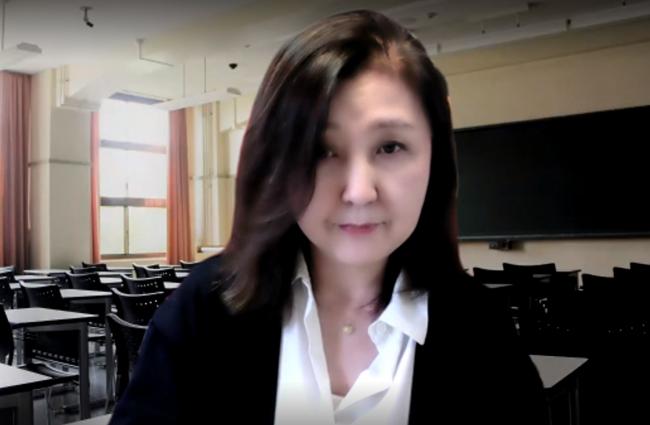
Professor Sugawara introducing ukiyo-e
A whisper for luck
Ukiyo-e emerged in the vibrant urban areas of Edo (present-day Tokyo), Kyoto, and Osaka during a time marked by relative peace and prosperity in Japan. That said, this era was not without its share of calamities, be they natural or human-induced disasters. In those unsettling moments, Japanese people turned to ukiyo-e as “good luck charms,” in Professor Sugawara’s words.
This was especially true for a particular type of ukiyo-e known as aka-e, or “red picture,” which is printed predominantly or even completely in red. Aka-e was said to be a talisman against smallpox, which raged among Japanese families during the Edo period and led to a spike in child fatalities.
“Traditionally in Japan, the color red is believed to bear the power to ward off misfortunes and diseases,” explained Professor Sugawara, as she introduced an aka-e titled “Kintaro fighting with a boar.” Kintaro, often translated as “Golden Boy,” is a legendary child from Japanese folklore renowned for his unparalleled strength.
“Red prints like this were widely printed, and people posted them on the walls of houses, or brought them around—carrying them, I mean—as good luck charms. This picture is embedded with the strong wishes of the people, such as, ‘Please don’t let me get the pox, or if I do get it, please make the symptoms moderate’.”
Produced relatively cheaply and in large numbers, ukiyo-e prints were cherished as a form of mass entertainment by commoners throughout Edo. Keeping these prints at home or carrying them around, Japanese people were probably wishing and whispering softly to themselves for a secure and tranquil life amidst a history riddled with hardships.
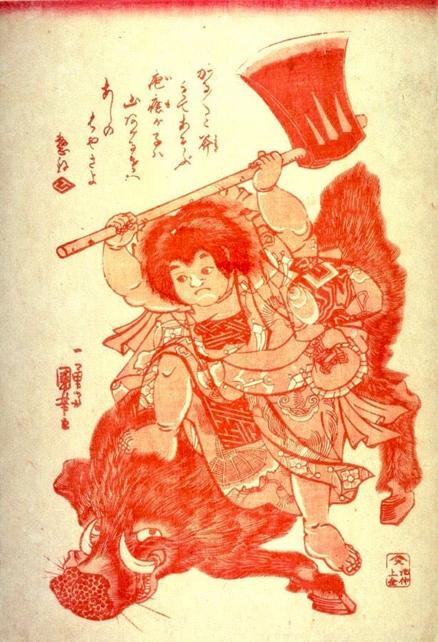
Kintarō no inoshishi taiji (Kintaro fighting with a boar), by Kuniyoshi Utagawa, 19th century. Tokyo Metropolitan Library.
Turning misfortunes into laughter: from natural disaster to pandemic
Not only pandemics but various other calamities disrupted Japanese people’s lives during the Edo time, but they weathered them all with remarkable poise, a rich sense of humor, and boundless positivity. Such attitudes were vividly captured in ukiyo-e, especially in its genre known as namazu-e. Namazu-e features depictions of a mythical giant catfish often blamed for various earthquakes happening during this period.
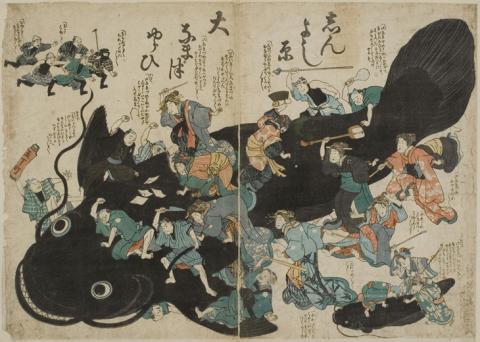 Shin Yoshiwara ōnamazu yurai (The Cause of the Great Catfish at Shin Yoshiwara), 1855. Ishimoto Mishio Collection, General Library in the University of Tokyo.
Shin Yoshiwara ōnamazu yurai (The Cause of the Great Catfish at Shin Yoshiwara), 1855. Ishimoto Mishio Collection, General Library in the University of Tokyo.
“This earthquake happened in October,” explained Professor Sugawara while showing a namazu-e addressing the Ansei Edo earthquake (Ansei Edo jishin 安政江戸地震) of 1855. “October is called kannazuki in Japan, which means the Month Without Gods. Because there were no gods present, the catfish began to move around, causing the big earthquake.”
Living deep in the earth, the catfish, according to the folk belief, is pinned down by a giant stone (kanameishi). During the tenth month in 1855, however, taking advantage of the gods’ absence, the catfish shook off the stone, thrashed its tail, and disaster ensued. The Ansei Edo earthquake is estimated to have killed and injured almost 10,000 people.
"Interestingly, the catfish was not necessarily regarded as a malevolent creature," elaborated Professor Sugawara. "The people in Edo had lost everything—their houses, their family members—because of the earthquake. But because everyone lost everything, everyone became poor, and consequently everyone became equal. That turned out to be a very bright note; that atmosphere is well represented in this print [The Cause of the Great Catfish at Shin Yoshiwara].”
In a similar way, the spirits of Edo residents were also kept intact through a massive cholera epidemic in the summer of 1858.
“Let’s take a look at the print by Utagawa Yoshikazu [Protective gods help good drugs cure vicious diseases],” Professor Sugawara explained while introducing another beloved ukiyo-e. “Riding on the clouds came a group of gods. And the figures with the spherical head, with the Japanese characters on top of it, are representing medicine. These are all the medicines. The medicine figures are fighting off the diseases, which are, in these figures, shown as if they were humans.
“This print was published in 1858, the year that cholera was a serious epidemic, killing 100 thousand people in the city of Edo alone. But when you look at this picture, you can feel a little bit of humor and a bright atmosphere.”
“It seems as if by looking at this picture, people were trying to overcome difficulty with laughter,” Professor Sugawara mused. “While looking at these works, you can see that no matter how difficult the situation was, the people of the Edo era always tried to laugh first.”
And that laughter has carried all the way through to today, as we continue to face a battle, now less intense yet still persistent, with COVID-19.
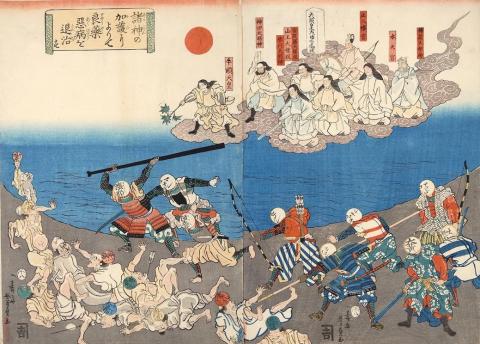 Shoshin no kago ni yorite ryōyaku akubyō o taijisu (Protective gods help good drugs cure vicious diseases), by Yoshikazu Utagawa, 1858. Tokyo Metropolitan Library.
Shoshin no kago ni yorite ryōyaku akubyō o taijisu (Protective gods help good drugs cure vicious diseases), by Yoshikazu Utagawa, 1858. Tokyo Metropolitan Library.
Ukiyo-e and COVID-19
Aside from those who actually suffered physically from the virus, COVID-19 has taken a profound toll on mental health in society, especially during the first wave of lockdowns. Through these uncertain times, people worldwide sought comfort through diverse means. Japanese people reached deep into their past to look for consolation, and once again, ukiyo-e has served as a beacon for guiding them to hope.
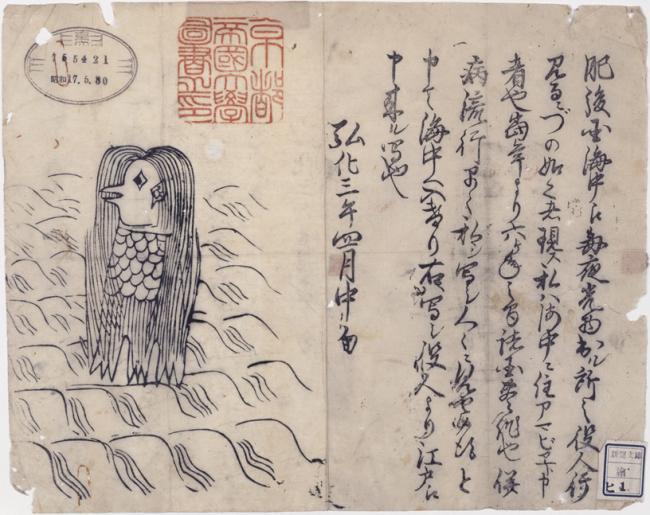
Amabie, ukiyo-e, 1846. Main Library, Kyoto University.
“This print suddenly became very popular in the spring of last year [2021], in the midst of the COVID pandemic,” Professor Sugawara explained, pointing out the ukiyo-e of a supernatural figure. “This creature is called Amabie.” Amabie images spread among not only Japanese but international Internet users under the Twitter hashtags of #amabie, #amabiechallenge, and #amabieforeveryone before garnering a following in other social platforms.
Professor Sugawara continued: “Amabie comes from the ocean. It is often referred to as a mermaid, but I am not sure that is a perfect translation. It is not the same as the Western concept of a mermaid; Amabie is more like a ghost or monster. This monster, however, bears a human-like face with the body of an animal, so there really isn’t a good direct translation.”
The legend of Amabie dates back to mid-May 1846. It is believed that Amabie made its appearance in Higo Province (now Kumamoto Prefecture), prophesying abundant harvests and, unfortunately, impending epidemics for the following 6 years. Amabie then instructed those who encountered it to show its picture to people as a means of defending themselves against diseases.
“Therefore, this mermaid gave us—all Japanese people—hope, in this very, very dark period of successive waves of COVID and of staying at home,” concluded Professor Sugawara.
Conclusion
As the Japanese proverb 災いを転じて福と成す (“turning disaster into good fortune”) suggests, the Japanese people have often endured challenges with both humor and grace. Ukiyo-e, in addition to showcasing the remarkable artistic talent of the Edo period, also adeptly captures and further enriches this resilience. Sooner or later, COVID-19 will become a part of the past, and new challenges will emerge. These challenges may take on different forms and arrive at various times, but what remains unchanged is the spirit that allows us to weather them. By seeking moments of joy even during the darkest times, we can create our own contemporary ukiyo-e, carrying that resilient laughter from the past to the present and for many more years to come.
References
Kintarō no inoshishi taiji (Tokyo Metropolitan Library)
Shoshin no kago ni yorite ryōyaku akubyō o taijisu (Tokyo Metropolitan Library)
Amabie (Main Library, Kyoto University)
Researcher’s details
Professor Mayumi Sugawara
Graduate School of Literature and Human Sciences
SDGs
